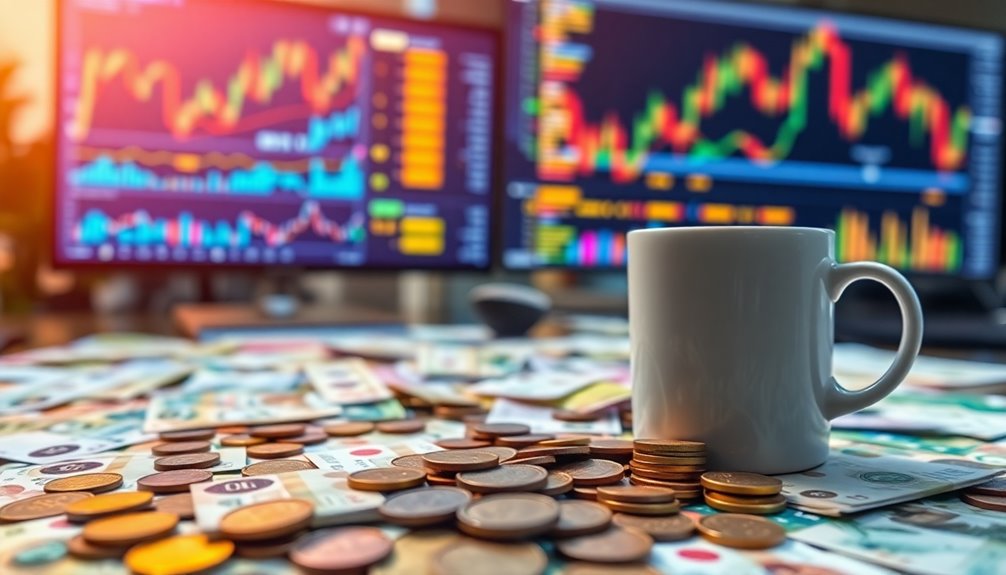Carrying trade is a strategy where you borrow in a currency with low interest rates, then invest those funds in a currency that offers higher returns. This method lets you profit from the difference in interest rates along with potential currency appreciation. You'll need to monitor currency fluctuations carefully, as they can significantly impact your earnings. Keep in mind that while it can be profitable, risks like exchange rate changes and market volatility can arise. Understanding these elements is crucial for effective trading, and there's much more to discover about making this strategy work for you.
Key Takeaways
- Carrying trade involves borrowing in a low-interest currency and investing in a higher-interest currency to profit from interest rate differentials.
- The profit arises from the interest rate difference and potential appreciation of the higher-yielding currency.
- This strategy carries risks, including exchange rate fluctuations and economic events that can impact profitability.
- Successful carrying trade requires monitoring economic indicators and implementing risk management strategies, such as diversification and stop-loss orders.
- Understanding the balance of risk and reward is essential for evaluating the viability of carry trades, especially in volatile markets.
Concept and Key Principles

When you dive into the concept of carrying trade, you'll quickly realize it's all about capitalizing on interest rate differentials between countries. You borrow in a currency with low interest rates and invest in one that offers higher rates. The objective? Profit from the difference.
Central banks set interest rates, influencing what commercial banks offer, so pay attention to those changes. If your high-interest currency appreciates against the low-interest one, you'll earn even more. Additionally, this strategy often involves borrowing in low-interest rate currencies to maximize potential returns.
However, stability is key; you want to avoid volatile currencies that can erode your profits. As you execute trades, keep an eye on risk management by setting stop-loss orders and adjusting positions based on interest rate shifts or currency fluctuations to protect your gains.
Understanding Currency Speculation

Currency speculation plays a crucial role in the foreign exchange market, where traders seek to profit from fluctuations in currency values. By taking on risks that others avoid, you help increase market liquidity and bridge the gap between buyers and sellers, ultimately fostering market efficiency. Engaging in currency speculation can create volatility in exchange rates, which may lead to rapid price fluctuations that impact trader behavior.
While speculative activities can lead to price discovery and more accurate exchange rates, they can also increase volatility, potentially resulting in price bubbles and market crashes.
To navigate this high-risk, high-reward landscape, you'll often use strategies like technical and fundamental analysis, along with market sentiment.
Interest Rate Differential Exploitation

Exploiting interest rate differentials is a key strategy in carry trades, where traders borrow in a currency with a low interest rate and invest in one with a higher rate.
By focusing on the interest rate differential, you aim to profit from the gap between what you pay on borrowed funds and what you earn from investments.
Using futures or forward currency markets can amplify your potential returns. Additionally, the success of carry trades can be linked to historical evidence showing that low-interest currencies tend to depreciate over time, while high-interest currencies often appreciate.
However, be aware that exchange rate movements can impact your profitability; if the target currency appreciates, your gains increase.
On the flip side, depreciation can wipe out profits.
Historical data shows that despite risks, such as market sentiment shifts and crowded trades, carry trades have been generally profitable over time.
Pros and Cons Overview

While carry trades can be an effective strategy for enhancing returns, they come with both significant advantages and notable risks.
On the positive side, you can benefit from high potential returns by earning from interest rate differentials and diversifying your portfolio across various assets and currencies. This flexibility allows you to tailor your investment approach to changing market conditions. Additionally, understanding interest-rate differentials is crucial to maximizing the benefits of carry trades.
However, you need to be cautious of exchange rate risks, as fluctuations can impact profitability. Additionally, carry trades can experience high volatility and significant drawdowns, especially in turbulent markets.
Lastly, the risk of rare crash states can lead to rapid depreciation of high-interest currencies, underscoring the importance of careful risk management in your trading strategy.
Risk Versus Reward Analysis

Carry trades offer the potential for significant profits, but understanding the balance of risk and reward is vital for success.
You need to be aware that interest rate changes can drastically impact your profitability. When high-interest countries lower rates, your returns may diminish. Currency volatility, especially with pairs like the Japanese yen, can also lead to losses. Additionally, central bank interventions can reverse gains you've made. Understanding the risk/reward ratio is essential for evaluating trade viability.
On the reward side, wide interest rate differentials and stable economic conditions can enhance your profits. Monitoring economic indicators and maintaining a positive risk appetite are crucial.
Ultimately, analyzing the risk/reward ratio helps you make informed decisions about whether to proceed with a carry trade. Stay vigilant to maximize your success.
Market Volatility Impacts Returns

Market volatility can significantly influence your investment returns, especially in carry trades. Higher volatility often leads to what's called volatility drag, where the losses in down years outweigh your gains in up years, ultimately reducing your long-term returns. This compounding effect means you're likely to see lower geometric average returns with more volatile assets. Less volatile portfolios tend to grow more consistently over time, while highly volatile ones can lose value despite occasional spikes. Additionally, volatility can trigger fear, causing you to make poor decisions, like selling in a downturn and missing future gains. Understanding these dynamics can help you manage risks effectively and make more informed choices about your investment strategy. Carry trades can also lead to significant market fluctuations, which further complicates volatility management.
Emerging Market Currency Fluctuations

Understanding market volatility is key, especially when it comes to emerging market currency fluctuations. Your currency values can swing significantly based on global risk appetite.
When investors feel optimistic, they pour money into emerging markets, boosting currency strength. However, during uncertain times, capital flows out, causing depreciation.
The US dollar's strength also plays a crucial role. A robust dollar often leads to capital flight from these markets, making their currencies weaker. Additionally, countries that peg their currencies may face crises if they can't maintain stability.
Additionally, domestic shocks, like political instability or high inflation, can create further volatility.
Leverage Economic Indicators Wisely

While navigating investments, leveraging economic indicators wisely can significantly enhance your decision-making process.
Start by understanding both leading and lagging indicators. Leading indicators, like the Consumer Confidence Index, can forecast future trends, while lagging indicators, such as the unemployment rate, confirm existing patterns.
Pay attention to key statistics like GDP and the CPI to gauge economic health. Use stock market indicators like the S&P 500 to assess market conditions. Additionally, consider sector-specific indicators for targeted insights. Economic indicators provide a broad picture of economic health and direction when taken together.
However, don't rely solely on one type; diversify your analysis to mitigate risks. Regularly update your strategies based on shifts in these indicators, ensuring you stay responsive to economic changes and make informed investment decisions.
Frequently Asked Questions
How Do Taxes Affect Profits From Carrying Trade?
Taxes can significantly impact your profits from carrying trade.
If you're classified as an investor, your gains may be taxed as capital gains, depending on your holding period.
If you qualify as a trader, you can deduct business expenses, and mark-to-market election might allow you to offset ordinary income with trading losses.
Properly reporting income and expenses is crucial to avoid audits and ensure you maximize your tax benefits.
What Currencies Are Most Commonly Used in Carrying Trade?
You'd think borrowing money at low rates would be a no-brainer, right?
Well, in the world of carry trades, currencies like the Japanese Yen and Swiss Franc are your go-to funding sources.
You'd then aim for higher-yielding currencies like the Australian and New Zealand Dollars.
The irony? You're hoping to profit from differences in interest rates, all while juggling the risks that come with market volatility.
Can Carrying Trade Be Automated Using Algorithms?
Yes, you can automate carry trades using algorithms. By programming algorithms to monitor real-time data on interest rates and exchange rates, you can quickly identify and execute profitable opportunities.
These automated systems handle trades instantly, minimizing manual effort. However, you'll need solid risk management strategies in place to address potential market fluctuations.
Plus, regular backtesting is essential to ensure the algorithm remains effective in changing market conditions.
How Does Political Stability Influence Carrying Trade Decisions?
Political stability significantly influences your carry trade decisions.
When a country is politically stable, you can expect predictable interest rates and a consistent regulatory environment, which reduces your risks. Instability, on the other hand, can lead to sudden interest rate changes and market volatility, making your investments less reliable.
With stable conditions, you gain investor confidence, encouraging capital flow into high-interest assets, ultimately enhancing your carry trade profitability.
What Role Do Central Banks Play in Carrying Trade?
Central banks play a crucial role in carry trades by setting interest rates that influence capital flows.
When you see low interest rates in advanced economies, it often encourages you to invest in emerging markets.
Their monetary policies also impact exchange rate stability, which is vital for successful carry trades.
If central banks react to inflation resulting from these inflows, it can affect your investment strategy and the overall economic landscape.
Conclusion
In conclusion, while the carry trade can offer enticing rewards through interest rate differentials, it's crucial to recognize the inherent risks. Market volatility and sudden shifts in economic indicators can quickly turn profits into losses. Some believe that leveraging emerging market currencies leads to greater gains, but this strategy can also amplify risks. Ultimately, understanding the balance between risk and reward is vital to navigating the complexities of carry trading successfully. Always stay informed and adaptable.









